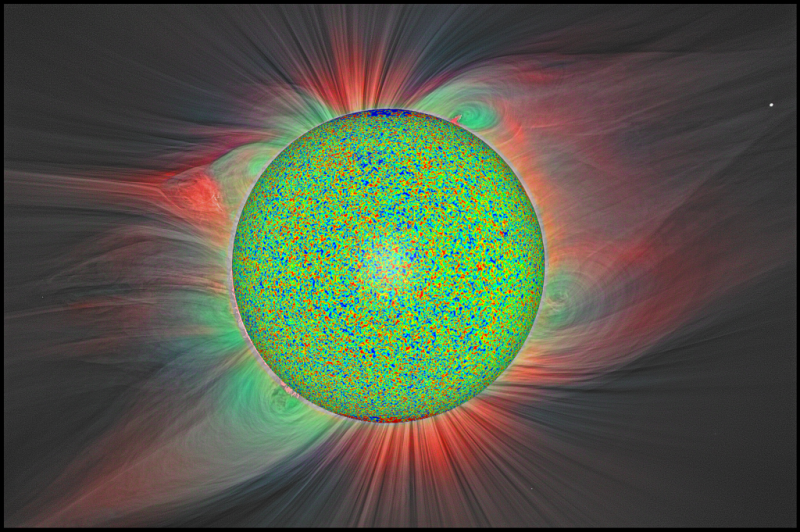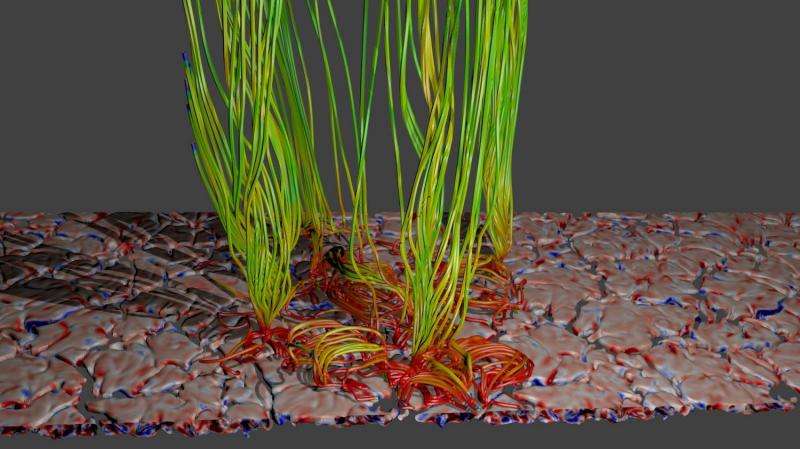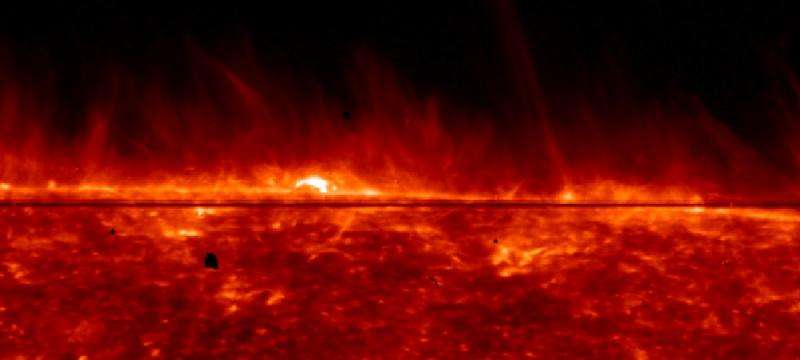June 11, 2015 report
Trio create model to explain massive heat in the Sun's corona

(Phys.org)—A trio of researchers, two with Ecole Polytechnique and the other with Université Paris, all in France, has created a computer model that is meant to show how it is that so much heat is in the sun's corona. In their paper published in the journal Nature, Tahar Amari, Jean-François Luciani and Jean-Jacques Aly describe their model, how it came about and why they think it is accurate.
For some time space scientists have been perplexed by research results that show the sun's corona is millions of degrees hotter than its surface. In this new effort, the researchers built a model that describes how that might occur and then offer some evidence to back up their claims.
Scientists know that on the sun's surface, rotating areas of gas create what are known as dynamos—where plasma causes charges to come about. In their model, the researchers suggest that when such dynamos "dump" their energy, it causes small eruptions to come about on the surface, allowing energy to dissipate out to the corona. The team describes their model as resembling a mangrove forest. The roots of the trees represent surface magnetic fields—energy makes its way up the trees and dissipates near the top like oxygen from tree leaves into the atmosphere, and that is how the energy reaches the corona.
The trio point to other observable phenomena that help bolster the credence of their theory—the fact that the temperature of the corona does not vary much over the course of sunspot cycles, for example, which they say is because the sun's magnetic field is not sensitive to it, because they are deeply rooted in the sun—their model describes shallow activity. Also, they note that other researchers have found evidence of solar tornadoes, which in a way are similar to the trees describe by the model and which can also transport heat up and off the surface. And finally, other observations have revealed that spectral lines of some elements are split into multiple components on the surface, which they team suggests would occur if there happened to be a magnetic field like the one they use in their model.
More research will have to be conducted both by the research team and others, of course, to see if the model will continue to hold up under scrutiny.
-

Model of the complex magnetic field on the Sun’s surface, resembling the roots and branches of mangroves, rooted in the boiling Sun. Credit: Tahar Amari /Centre de physique théorique.CNRS-Ecole Polytechnique.FRANCE -

Emissions from various layers of the solar atmosphere, using data from the NASA Iris mission. Credit: Tahar Amari /Centre de physique théorique.CNRS-Ecole Polytechnique. FRANCE
More information: Small-scale dynamo magnetism as the driver for heating the solar atmosphere, Nature 522, 188–191 (11 June 2015) DOI: 10.1038/nature14478
Abstract
The long-standing problem of how the solar atmosphere is heated has been addressed by many theoretical studies, which have stressed the relevance of two specific mechanisms, involving magnetic reconnection and waves, as well as the necessity of treating the chromosphere and corona together. But a fully consistent model has not yet been constructed and debate continues, in particular about the possibility of coronal plasma being heated by energetic phenomena observed in the chromosphere. Here we report modelling of the heating of the quiet Sun, in which magnetic fields are generated by a subphotospheric fluid dynamo intrinsically connected to granulation. We find that the fields expand into the chromosphere, where plasma is heated at the rate required to match observations (4,500 watts per square metre) by small-scale eruptions that release magnetic energy and drive sonic motions. Some energetic eruptions can even reach heights of 10 million metres above the surface of the Sun, thereby affecting the very low corona. Extending the model by also taking into account the vertical weak network magnetic field allows for the existence of a mechanism able to heat the corona above, while leaving unchanged the physics of chromospheric eruptions. Such a mechanism rests on the eventual dissipation of Alfvén waves generated inside the chromosphere and that carry upwards the required energy flux of 300 watts per square metre. The model shows a topologically complex magnetic field of 160 gauss on the Sun's surface, agreeing with inferences obtained from spectropolarimetric observations, chromospheric features (contributing only weakly to the coronal heating) that can be identified with observed spicules and blinkers, and vortices that may be possibly associated with observed solar tornadoes8.
Journal information: Nature
© 2015 Phys.org





















